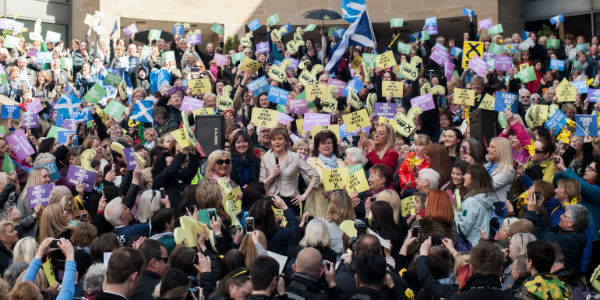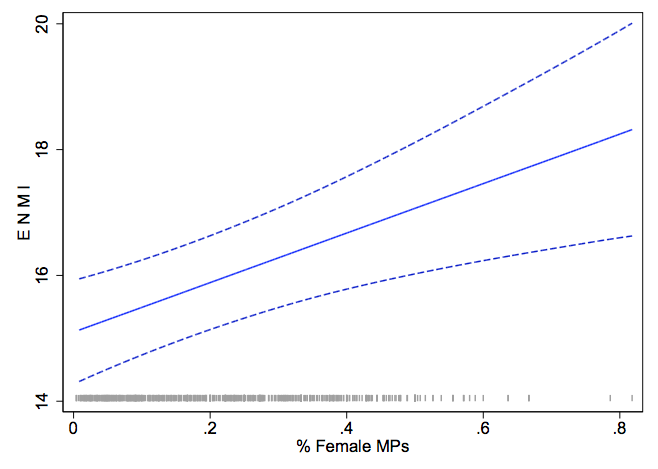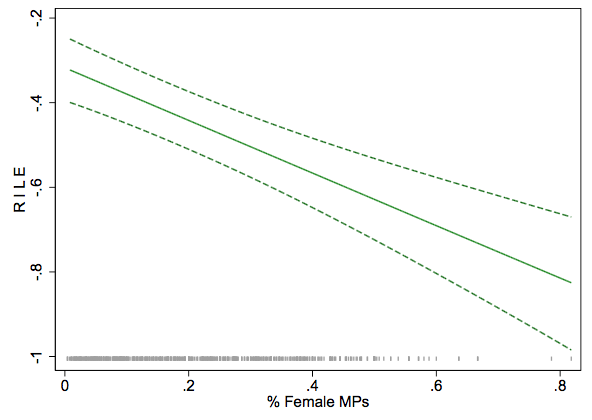New women MPs shift their party leftwards – but female leaders don’t
What happens when voters elect more female MPs? Zac Greene and Diana O’Brien reveal that the presence of more women broadens the range of issues discussed, but has no impact on introducing new issues to party manifestos. The presence of women MPs shifts a party markedly to the left – though there is no evidence a female leader has the same effect.

Scottish First Minister and SNP leader Nicola Sturgeon presents the Women’s Pledge at the Royal Concert Hall, Glasgow. Photo: SNP via a CC-BY-NC-ND 2.0 licence
2016 has seen the rise of several prominent female politicians, including Theresa May in the UK, Nicola Sturgeon in Scotland, and Kersti Kaljulaid in Estonia. Of course, Hillary Clinton also became the first female nominee from a major party to run for the US presidency. Yet despite the growing number of female parliamentarians and leaders, their effect on party and government policy agendas is poorly understood. Though research shows that female politicians have distinct policy preferences and issue priorities, studies remain largely silent on the impact female politicians have on parties’ election platforms and campaigns.
Our recent European Journal of Political Research article argues that diversity among parties’ politicians can in turn diversify their policy agendas. In particular, if female politicians hold distinctive viewpoints – and give voice to these perspectives – parties that elect more women may also be more willing to
1) innovate on topics that were previously non-politicised
2) present a broader range of issues on their policy agendas.
Because of the types of issues women prioritise, moreover, we should also observe that parties in the aggregate
3) shift their ideological position to the left.
These hypotheses are consistent with the growing literature on intra-party politics.
We investigated these claims using information about 110 parties’ election manifestos from 20 OECD countries between 1952 and 2011. To this Comparative Manifestos Project data, we added a unique dataset that measures the proportion of the parties’ parliamentary seats held by women and the presence of a female leader. Our results suggest that female members of parliament (MPs) increase the breadth of their parties’ agendas and push these manifestos to the left. Women do not, however, influence issue entrepreneurship.
To capture issue diversity (labelled the Effective Number of Issues, following Greene 2016) we created a measure that accounts for both the total number of issues included in the manifesto and the relative amount of attention paid to each issue. Figure 1 illustrates the predicted number of issues based on the proportion of female MPs in parties’ parliamentary delegations (95% confidence intervals). Parties with more female MPs in the last election saw an increase in the number of issues they discussed in the current election. Indeed, the effect is large: comparing parties with low and high levels of women’s representation (one standard deviation above and below the mean proportion of female MPs) results in a 4.4% change in the effective number of issues. This corresponds to approximately one additional issue on the policy agenda. The presence of a female leader likewise increases platform diversity.

Figure 1: Predicted effective number of manifesto issues
We also expect female MPs to hold more left-leaning positions as compared to their male party colleagues, and thus to pull their parties leftward. To capture ideology, we use a logged version of the parties’ left-right position signalling parties’ positions on the biggest economic dimension of conflict. Figure 2 shows that parties with more female MPs in the last election hold more left (negative) positions in their current manifestos. Again, the predicted difference between parties with relatively low and high proportions of female MPs is substantively meaningful, leading to a five percentage point difference over the range of the left-right scale. We find no such effect for female party leaders, however.

Figure 2: Predicted left-right positions (RILE – more positive positions indicate more economically conservative)
While female politicians affect issue diversity and parties’ left-right positions, their presence has no effect on issue entrepreneurship. We examined instances in which a party included an issue in its manifesto that had never previously been addressed in that country. We find no relationship between this (albeit conservative) measure and the proportion of female parliamentarians or party leaders.
Together, these results indicate that a rise in the number of female MPs affects the policy agenda within both parties and the political system. They reveal previously unexplored consequences of women’s representation and shed new light on the role intra-party politics plays in the policymaking process. Furthermore, that suggest that regardless of parties’ attempts to attract voters from diverse backgrounds, their official campaign materials will probably only incorporate diverse ideas when those with unique experiences and viewpoints are themselves incorporated into the parties’ decision-making process. Importantly, they suggest that by broadening the party’s focus, diversity improves the quality of representation for all citizens.
This post represents the views of the authors and not those of Democratic Audit.

 Zac Greene is a Chancellor’s Fellow in Politics at the University of Strathclyde.
Zac Greene is a Chancellor’s Fellow in Politics at the University of Strathclyde.
Diana O’Brien is an Assistant Professor in Political Science at Indiana University.





 Democratic Audit's core funding is provided by the Joseph Rowntree Charitable Trust. Additional funding is provided by the London School of Economics.
Democratic Audit's core funding is provided by the Joseph Rowntree Charitable Trust. Additional funding is provided by the London School of Economics.
[BLOG] How gender might affect #PoliticalParty ideology&policy, in terms of party leaders &MPs via @democraticaudit https://t.co/nPBgYFHMW6
New women MPs shift their party leftwards – but female leaders don’t https://t.co/BVjJIY1Fiz
Find out what changes in a political party when it gets more female MPs – and what doesn’t https://t.co/DPthHWfims
New women MPs shift their party leftwards – but female leaders don’t https://t.co/zguyL8bf3I
New women MPs shift their party leftwards – but female leaders don’t https://t.co/DPthHWfims https://t.co/EDvyxDp4OJ